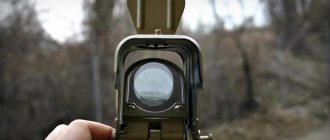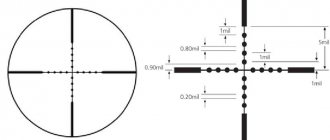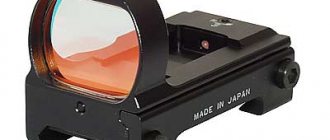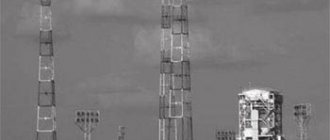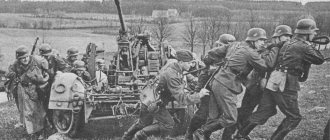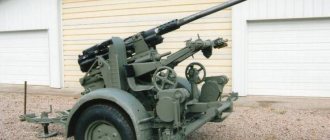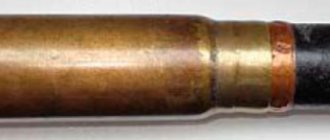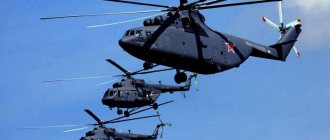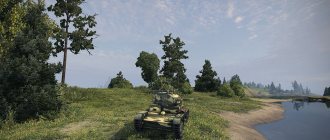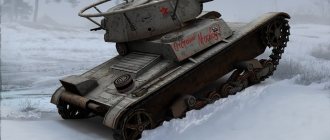This term has other meanings, see USP.
This term has other meanings, see Tulip.
| USP-1 (1P29) | |
| USP-1 on the AN-94 assault rifle | |
| Type: | universal optical sight |
| A country: | USSR USSR Russia Russia |
| Service history | |
| Years of operation: | USSR USSR: since 1988 |
| In service: | USSR USSR Russia Russia |
| Wars and conflicts: | Crimean crisis[1] |
| Production history | |
| Constructor: | L. A. Glyzov, Central Design Bureau "Tochpribor" |
| Manufacturer: | Novosibirsk Instrument-Making Plant |
| Characteristics | |
| Weight, kg: | 0,8 |
| Length, mm: | 203 |
| Width, mm: | 178 |
| Height, mm: | 80 |
USP-1USP-1
USP-1 “Tulip”
(from
the Unified
Sniper Rifle
Sight
,
first sample), index GRAU
1P29
- Soviet/Russian unilluminated universal optical sight, designed for targeted shooting from machine guns of the family (AKMN, AK-74, AK74N, AK-74M, AK-101, AK -102, AK-105), RPK-74N machine guns, PKMN and Pecheneg machine guns at any time of the day. Compared to an open mechanical sight, the firing efficiency of small arms in terms of the frequency of hitting targets increases by 1.2-2 times, and the time to complete fire missions is reduced by 1.5 times. Developed at the Tochpribor Central Design Bureau (Novosibirsk). Production is established at the Novosibirsk Instrument-Making Plant.
Links
- [gunsru.ru/rg_pricel_USP-1_ru.html Description of the USP-1 sight on the website gunsru.ru]
- [www.ak-info.ru/joomla/index.php/devices/9-optics/55-usp1about Description of the USP-1 sight on the website www.ak-info.ru]
- [russianguns.ru/?p=2999 Description of the USP-1 optical sight on the website russianguns.ru]
- [zastava-izhevsk.ru/index.php?productID=671 Review and comparative description of the USP-1 sight and its civilian modifications]
- [pravoslav-voin.info/pravvoiny/692-kollimatornyj-pricel-umenshaem-shansy-vraga.html Review of military collimator sights]
Excerpt characterizing USP-1
The Karagins' house was the most pleasant and hospitable house in Moscow that winter. In addition to parties and dinners, every day a large company gathered at the Karagins, especially men, who dined at 12 o'clock in the morning and stayed until 3 o'clock. There was no ball, party, or theater that Julie missed. Her toilets were always the most fashionable. But, despite this, Julie seemed disappointed in everything, told everyone that she did not believe in friendship, nor in love, nor in any joys of life, and expected peace only there. She adopted the tone of a girl who had suffered great disappointment, a girl as if she had lost a loved one or had been cruelly deceived by him. Although nothing of the sort happened to her, they looked at her as if she were one, and she herself even believed that she had suffered a lot in life. This melancholy, which did not prevent her from having fun, did not prevent the young people who visited her from having a pleasant time. Each guest, coming to them, paid his debt to the melancholy mood of the hostess and then engaged in small talk, dancing, mental games, and Burime tournaments, which were in fashion with the Karagins. Only some young people, including Boris, delved deeper into Julie’s melancholic mood, and with these young people she had longer and more private conversations about the vanity of everything worldly, and to them she opened her albums covered with sad images, sayings and poems. Julie was especially affectionate towards Boris: she regretted his early disappointment in life, offered him those consolations of friendship that she could offer, having suffered so much in life herself, and opened her album to him. Boris drew two trees in her album and wrote: Arbres rustiques, vos sombres rameaux secouent sur moi les tenebres et la melancolie. [Rural trees, your dark branches shake off darkness and melancholy on me.] Elsewhere he drew a tomb and wrote: “La mort est secourable et la mort est tranquille “Ah! contre les douleurs il n'y a pas d'autre asile.” [Death is salutary and death is calm; ABOUT! there is no other refuge against suffering.] Julie said it was lovely. “II ya quelque chose de si ravissant dans le sourire de la melancolie, [There is something infinitely charming in the smile of melancholy," she said to Boris word for word, copying this passage from the book. – C'est un rayon de lumiere dans l'ombre, une nuance entre la douleur et le desespoir, qui montre la consolation possible. [This is a ray of light in the shadows, a shade between sadness and despair, which indicates the possibility of consolation.] - To this Boris wrote her poems: “Aliment de poison d'une ame trop sensible, “Toi, sans qui le bonheur me serait impossible, "Tendre melancolie, ah, viens me consoler, "Viens calmer les tourments de ma sombre retraite "Et mele une douceur secrete "A ces pleurs, que je sens couler." [Poisonous food of an overly sensitive soul, You, without whom happiness would be impossible for me, Tender melancholy, oh, come, comfort me, Come, soothe the pangs of my gloomy solitude, And add a secret sweetness To these tears that I feel flowing.] Julie played the saddest nocturnes on the harp for Boris. Boris read Poor Liza aloud to her and more than once interrupted his reading from the excitement that took his breath away. Meeting in a large society, Julie and Boris looked at each other as the only indifferent people in the world who understood each other.
Modern Russian sights for small arms
Small arms are the main type of weapons of any army in the world. It is used in armed conflicts of any intensity. Moreover, the effectiveness of its use depends not only on the characteristics of the weapon itself and the level of training of military personnel, but also on the sighting devices installed on it. Today, Russian industry produces a full range of sights for small arms: optical, collimator, night and thermal imaging, which make the shooter’s life much easier. When using standard mechanical sights, the shooter always experiences certain inconveniences; his eyes get tired quite quickly. The front sight or the slot of the front sight is visible vaguely, unsharply, so the shooter is not always able to clearly observe the target, the slot, and the front sight, since they are at different distances from him. Because of this, the eye is constantly tense, it adjusts the visual effort to clearly fix these points. The longer the shooter looks, the more tired the eye becomes, which may begin to water. However, do not forget that any inaccuracy can lead to poor shooting.
Optical sights are much more advanced. Their use can improve shooting accuracy by enlarging the target and eliminating over-accommodation of the eye. In optical sights, the aiming mark and the target image are combined in the focal plane of the optical system lens. At the same time, optical sights have a number of features. In particular, they have a limited field of view (which can make it difficult to find a target), as well as a constant exit pupil diameter, which, depending on the viewing conditions, can vary from 2 to 8 mm. In addition, when observing a target through an optical sight, the eye pupil must be aligned with the exit pupil of the device, otherwise errors in aiming may occur. Red dot sights do not have these disadvantages. And night and thermal imaging sights, as you might guess from the name, allow you to conduct targeted fire at night and in conditions of poor visibility.
Sniper optical sight PSO-1M2
PSO-1 stands for optical sniper sight. This is one of the main sights of Russian and Soviet sniper weapons. It was created back in 1963 specifically for the new sniper rifle - SVD. Since then, these sights have been used in almost all local wars and conflicts, including in the CIS. Its design feature is a very successful sighting reticle, which allows the sniper to quickly determine the distance to the target and make appropriate horizontal adjustments during shooting without rotating the flywheels. The PSO sight is sealed; it is filled with nitrogen, which eliminates fogging of the sight optics during significant temperature changes. It remains operational in the temperature range from -50 to +50 °C.
PSO-1M2
The production of these sights is carried out by Novosibirsk Instrument-Making Plant OJSC, which is part of the Shvabe - Defense and Protection holding company. Currently, the company produces two modernized versions of the PSO-1 sight - these are the PSO-1M2 and PSO-1M2-1 sights. The first of them is used together with the Dragunov sniper rifle (SVD) of 7.62 mm caliber. The sighting scales are designed for firing at distances from 100 to 1300 meters. The second sight is intended for use in conjunction with a special sniper rifle (rifled) VSS "Vintorez" of 9 mm caliber, as well as a special sniper assault rifle AS "Val" of 9 mm caliber. The sighting scales of these sights are designed for firing at distances from 100 to 400 meters. For firing at dusk, they have an illuminated reticle. The power source is a regular standard AA battery.
Characteristics of the PSO-1M2 sight:
Overall dimensions - 375x70x132 mm. Magnification, multiple - 4. Resolution limit, arc seconds - 12. Field of view - 6°. The diameter of the exit pupil is 6 mm. Eye relief - 68 mm. Weight - 0.6 kg.
Sniper optical sights "Hyperon"
The developer of the Hyperon sights is chief designer B.P. Maikov. The developer and manufacturer of sights is JSC Krasnogorsk Plant named after. S. A. Zvereva (Krasnogorsk, Moscow region), the plant is part of the Shvabe - Defense and Protection holding company. Pancratic sniper sights of the Hyperon series are designed for targeted shooting and reconnaissance of targets from sniper rifles. The sights provide automatic input of the aiming angle in the process of measuring the range to the target and provide high accuracy of firing at a distance of 100 to 1000 meters both in the daytime and at dusk. The sight was adopted by the Russian army in 2001.
1P59 on SVD
Currently, the company produces 3 types of these sights: 1P59 for the SVD sniper rifle, 1P69 for the SV-98 sniper rifle and 1P71-1 for the ASVK large-caliber sniper rifle (12.7 mm). The use of the 1P59 "Hyperon" sniper scope with SVD allows you to increase the efficiency of shooting from a sniper rifle that uses a standard PSO-1 by 1.3-2 times (depending on the size of the target and the range to it) due to greater magnification and combination of operations input of aiming angles and measurement of the range to the target, a more accurate rangefinder, as well as the location of the scale for entering aiming angles in the field of view of the sight.
1P69 on SV-98
By using a pancratic change in magnification, a method is used to measure the range to a target of known sizes, which is based on a smooth change in magnification until the visible target is completely included in the rangefinder mark of the device. The rangefinder mark of the Hyperon sight is made in the form of strokes (the length of the strokes and the gaps between the strokes correspond to the width of a person’s shoulders at the corresponding range). In addition, the rangefinder mark allows the shooter to accurately determine the distance to targets having basic dimensions - 1.7 meters (height figure), 0.75 meters (chest figure), and also simultaneously enter aiming angles. Sights 1P59 and 1P69 provide targeted shooting at distances from 100 to 1300 meters, sight 1P71-1 at distances from 100 to 1500 meters. The sight is able to operate in the temperature range from -50 to +50 °C; it uses ER6P type lithium elements to illuminate the target.
1P71-1
Characteristics of the Hyperon sights:
Magnification, times - 3-10. Angular field of view - 7.6-2.5°. Resolution limit, arc seconds - 3 times: 20; 10x: 6. Exit pupil diameter - 10-4 mm. Eye relief - 70 mm. Length with lens hood and eyecup - 410 mm. Weight including bracket 1P59 - 1300 g, 1P69 and 1P71-1 - 1350 g.
Shooting sights 1P76, 1P77 and 1P78
These sights were developed by JSC Novosibirsk Instrument-Making Plant and are intended for installation on various types of automatic small arms: machine guns and machine guns. Sights are designed for observing the battlefield, selecting a target and determining the range to it, conducting aimed fire from machine guns and machine guns during the day, as well as at dusk and at night at illuminated or luminous targets. All sights are small in size and have a large field of view. All of them are able to operate at temperatures from -50 to +50 °C.
1P76
The 1P76 sight was developed at the Tochpribor Central Design Bureau in the city of Novosibirsk, the chief designer of the sight is A. A. Petrov. The sight is intended for installation on AKM, AK-74, AK-100 series assault rifles, as well as AN-94 and RPK-74M, RPK-74N and RPKN light machine guns. The sight has a wide field of view and single magnification, which allows a soldier in dynamic combat conditions to quickly monitor the terrain simultaneously through the sight and with the naked eye without loss of visibility. To minimize the size and weight of the sight, it used an alignment mechanism with lens movement and a Pehan prism wrapping system. The aiming reticle is illuminated with a tritium light element. The color of the reticle is black during the day and green at night.
Technical characteristics of 1P76:
Overall dimensions - 110x60x190 mm. Magnification, x - 1. Field of view - 13°. Resolution limit, arc seconds - 60. Exit pupil diameter - 20 mm. Eye relief - 100 mm. Weight - 0.3 kg.
The 1P77 day sight was created by order of the Russian Ministry of Defense in 2005. The sight was created on the basis of the optical circuits of E. G. Popov by a team of developers consisting of T. A. Kuznetsova, S. I. Mikhalenko and T. K. Sinitsina. The sight is intended for installation on the Pecheneg and PKMN light machine guns. The main requirement during its development was to provide magnification at the level of the PSO-1 sniper scope. The 1P77 sight uses an optical design with a revolving prism system, which is implemented on a Pehan prism, with input of aiming angles by moving the sight reticle. In this case, the entered range is indicated in the lower part of the shooter’s field of view. Alignment of the weapon is carried out by moving the lens. The backlight, as in 1P76, is implemented using a tritium light element. This sight provides a firing range of 400-1200 meters.
1P77 on the Pecheneg machine gun
Technical characteristics of 1P77:
Overall dimensions - 205x95x171 mm. Magnification, x – 4. Field of view – 10°. Resolution limit, arc seconds - 12. Exit pupil diameter - 6 mm. Exit pupil relief: 32 mm. Weight - 0.95 kg.
The 1P78 sight was created in Novosibirsk at the Tochpribor Central Design Bureau under the leadership of chief designer S.I. Mikhalenko. This day sight is available in 4 versions: 1P78 for the AKMN assault rifle; 1P78-1 for AK-74M, AK-74N, AKS74N and AN94 assault rifles; 1P-78-2 for RPK 74M and RPK 74N light machine guns; 1P-78-3 for the RPKN light machine gun. The sights differ in their sighting reticles and weapon mounting brackets. All sights use an optical design that is similar to that used on the 1P77 sight. The firing range with the 1P78 sight is 300-600 meters, with the rest - 400-700 meters.
Technical characteristics of 1P78:
Overall dimensions - 175x85x165 mm; 1P78-1 - 200x90x170 mm; 1P78-2 - 190x85x165 mm; 1P78-3 - 170x90x170 mm. Magnification, times - 2.8. Field of view - 13°. Resolution limit, arc seconds - 19. Exit pupil diameter - 6 mm. Exit pupil relief: 32 mm. Weight - 1P78 and 1P78-3 - 0.7 kg; 1P78-1 and 1P78-2 - 0.75 kg.
Collimator sight 1P63
The 1P63 collimator sight for AK-74, AKMN, AN-94 assault rifles, Kalashnikov hundredth series and RPK 74M, RPK 74N and RPKN light machine guns was created in Novosibirsk at the Tochpribor Central Design Bureau by designer S. I. Mikhalenko. Currently, the sight is produced by Novosibirsk Instrument-Making Plant OJSC. Designed for conducting targeted fire during the day, at dusk and at night against illuminated targets from automatic weapons that have a side seat for installation. Aiming is done using the reticle, the image of which is located at infinity. Can be used at direct shot range against visible moving and stationary targets. Able to operate at temperature extremes from -50 to +50 °C.
1P63
The use of this sight ensures simplicity and convenience of aiming, which during the moving phase of the battle, as well as in conditions of limited time for opening fire from unstable positions and when firing from automatic weapons, significantly increases the efficiency of shooting by reducing aiming errors and aiming time.
In the daytime, the aiming mark is a triangle, two horizontal strokes and one vertical white stroke; at night the strokes change color to green. At dusk, both the triangle and the strokes are visible. In the daytime, the sight reticle is illuminated using sunlight, at night and at dusk - using a radioluminescent source. The sight stands out for its small dimensions. Technical characteristics of 1P63:
Overall dimensions - 133x152x68 mm. Magnification, x - 1. Field of view - 13°. Weight - 0.6 kg.
Night sights 1PN-93 "Magnus"
Sights of the 1PN-93 series were created at the Tochpribor Central Design Bureau in Novosibirsk under the leadership of chief designer P. G. Golubev. Currently produced by JSC Novosibirsk Instrument-Making Plant. The first device of this group was designed and released in 1995. Subsequently, thanks to the implementation of the modular design, its individual elements were used to create a number of small-sized night sights of a new generation: 1P93-1, 1P-93-2, 1P-93-3 and 1P-93-4. These sights were adopted by the Russian army. Moreover, the products of this group cover all types of modern Russian weapons from machine guns to grenade launchers and sniper rifles. All sights have successfully passed military service, including during anti-terrorist operations in Chechnya.
Night sights 1PN-93 are designed for observation, reconnaissance of the area and conducting targeted fire in the dark under the light of the Moon and stars. The sights are equipped with mechanisms for adjusting height and direction, introducing aiming angles, and have an illuminated reticle with two positions for adjusting the brightness of the glow. Can be used at air temperatures from -50 to +50 °C. The first three sights use an image intensifier, a generation 2+ electro-optical converter, while the 1PN-93-4 sight has a 3rd generation image intensifier. To operate during daylight hours, the sights are equipped with a removable filter or diaphragm. The sights use 1 AA power source, the operating time on one AA battery is 10 hours.
1P93-4
The 1PN93-1 sight can be used with AK-74, AK-74M, AK hundredth series, AN-94, VSS and AS “Val” assault rifles (vision range in moonlight is 350 meters). The 1PN93-2 sight is used with the AK-74, AK-74M, AK 100 series, AN-94 and the RPG-7V grenade launcher (vision range in moonlight - 400 meters). The 1PN93-3 sight can be installed on the SVD and PKM light machine gun (vision range in moonlight - 500 meters). The 1PN-93-4 sight is installed only on the Dragunov sniper rifle (vision range in moonlight - 600 meters).
Technical characteristics of 1P93:
Overall dimensions - 1P93-1 - 207x176x79 mm; 1P93-2 - 207x193x90 mm; 1P93-3 - 220x198x100 mm; 1P93-4 - 250x190x81 mm. Magnification, times - 1P93-1, 1P93-2 and 1P93-4 - 4; 1P93-3 - 5. Field of view - 1P93-1 and 1P93-2 - 7°; 1P93-3 - 5°; 1P93-4 - 10°. The diameter of the exit pupil is 6 mm. Weight - 1P93-1 - 0.95 kg; 1P93-2 - 1.2 kg; 1P93-3 and 1P93-4 - 1.25 kg.
Thermal imaging sight "Shahin"
The Shakhin optical device (white falcon or peregrine falcon subspecies) is the only uncooled thermal imaging sight completely domestically developed and produced. This thermal imaging sight was created at OJSC Central Research Institute "Cyclone" (Moscow), which is part of the Ruselectronics holding. The sight is able to operate at temperatures from -40 to +50 °C. Can be used in various small arms from machine guns, rifles and carbines to light and heavy machine guns. The sight provides round-the-clock target detection and aiming from various positions: standing, lying down, kneeling in any combat situation (dust, smoke, etc.). Moreover, “Shahin” is a passive device that does not require any artificial light sources. Installing the sight on a weapon is carried out using a special bracket and takes only a few minutes.
This sight is part of the new generation “Ratnik” combat equipment. In the Shahin lens, objects can be distinguished by color, even if the difference in their temperatures does not exceed a tenth of a degree. At room temperature, the scope can operate for up to 6 hours. It takes no more than 10 seconds to turn it on and pre-calibrate it. Moreover, with the help of this sight you can detect a person at a distance of up to 2 kilometers, and from a distance of one and a half kilometers you can open targeted fire. The sight has a special program that allows you to take into account the ballistics of ammunition. At the same time, ballistics for 4 different types of weapons (cartridges) can be stored in the Shahin’s memory at the same time.
Currently, there is information about three types of sights, which differ in weight and capabilities. The minimum weight of the sight is 1.2 kg. The heaviest version of the sight has a matrix with a resolution of 640x480 pixels. This sight is equipped with a special connector, which is designed to transmit images to the shooter’s helmet-mounted display or recording device. The image transmission from “Shakhin” occurs via cable. Thanks to the implementation of this feature, a soldier can point his weapon around a corner at arm's length and, while remaining safe, see what is happening around the corner.
Technical characteristics of "Shahin-3":
Overall dimensions - 290x130x130 mm. Matrix resolution, pixels - 640x480. Magnification, times - 2.2. Digital zoom - 2. Field of view according to GxV - 7°x5.5°. Focusing range - 15 m - ∞. Weight - 1.4 kg.
Sources of information: https://www.npzoptics.ru (JSC Refinery) https://www.zenit-foto.ru (JSC Krasnogorsk Plant named after Zverev) https://www.cyclone-jsc.ru (JSC Central Research Institute " Cyclone") https://rostec.ru (Rostec State Corporation) https://gunsru.ru https://russianguns.ru
